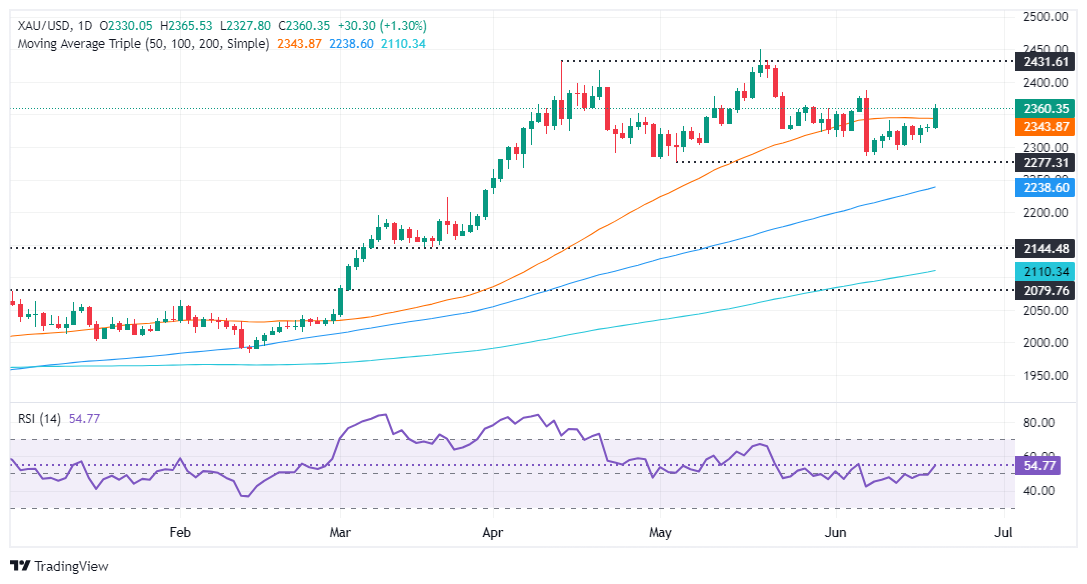- Gold advances sharply, gaining more than 1% amid weakening US economic indicators.
- Weaker US jobs and housing data raise expectations of two 25bp rate cuts by the Fed in 2024.
- Rising geopolitical tensions in the Middle East and the pact between North Korea and Russia increase Gold’s appeal as a safe haven.
Gold prices rose sharply more than 1% on Thursday during the North American session, as US Treasury yields moved up to support the Dollar. US data was weaker than expected, increasing traders’ confidence that the Federal Reserve (Fed) will ease policy at least twice in 2024. XAU/USD is trading at $2,356 at the time of writing .
The latest US economic data continued to show that the economy is slowing, leading investors to forecast two 25 basis point (bp) interest rate cuts. A worse-than-expected US jobs report revealed that the number of Americans filing for unemployment benefits exceeded estimates.
US housing data disappoints markets as building permits and housing starts cooled.
Meanwhile, Minneapolis Fed President Neel Kashkari stated that it will likely take a year or two to reduce core inflation to 2%. He added that the path of interest rates will depend on economic conditions, emphasizing, “We are achieving disinflation despite notable economic growth.”
Rising geopolitical risks helped the gold metal’s bullish trend. Tensions in the Middle East are rising as Israel threatens to launch an attack against Hezbollah in Lebanon. That, along with the recently signed pact between Russia and North Korea, could increase the appeal of the yellow metal, which is trading near a crucial resistance level.
The CME FedWatch tool shows the odds of a 25bp rate cut for September standing at 58%, up from 62% a day ago. Meanwhile, the December 2024 fed funds futures contract implies the Fed will cut 36 bps by the end of the year.
Daily movements and market drivers: Gold price rises amid high US yields and a strong Dollar
- The US Dollar Index prints gains of 0.405, rising to 105.64, a headwind for Gold prices.
- US Treasury yields jumped, with the yield on the 10-year Treasury note rising more than four basis points to 4.257%.
- US Initial Jobless Claims for the week ending June 15 rose to 238,000, above estimates of 235,000 but below the previous reading of 243,000.
- US building permits decreased 3.6% in May, falling from 1.44 million to 1,386 million. Housing starts for the same period fell 5.5%, from 1,352 million to 1,277 million.
- Fed officials advised patience in interest rate cuts and stressed that they would remain dependent on data. Although last week’s CPI report was positive, policymakers reiterated that they need to see more reports like the May data.
- Even though the US CPI report shows that the disinflation process continues, Fed Chairman Jerome Powell commented that they remain “less confident” about progress in inflation.
Technical Analysis: Gold Price Challenges Head-Shoulder Pattern, Rises Above $2,350
Gold buyers are testing the head and shoulders pattern, dragging the gold metal above the pattern’s neckline. A daily close above the confluence of the latter and the 50-day SMA around $2,343 could negate the bearish chart pattern and open the door for more gains.
In that case, Gold could extend its gains above $2,350, exposing additional key resistance levels. Next would be the June 7 cycle high of $2,387, before challenging the $2,400 figure.
On the contrary, if XAU/USD falls below $2,343, that would keep the shoulder-head-shoulder pattern on the chart intact, and Gold could head lower. If XAU/USD falls below $2,300, the next support would be the May 3 low of $2,277, followed by the March 21 high of $2,222. More losses lie below, with sellers targeting the head-shoulder pattern target of $2,170 to $2,160.
Gold
Gold has played a fundamental role in human history, as it has been widely used as a store of value and medium of exchange. Today, apart from its brilliance and use for jewelry, the precious metal is considered a safe haven asset, meaning it is considered a good investment in turbulent times. Gold is also considered a hedge against inflation and currency depreciation, since it does not depend on any specific issuer or government.
Central banks are the largest holders of Gold. In their aim to support their currencies in turbulent times, central banks tend to diversify their reserves and purchase Gold to improve the perception of strength of the economy and currency. High Gold reserves can be a source of confidence for the solvency of a country. Central banks added 1,136 tons of gold worth about $70 billion to their reserves in 2022, according to data from the World Gold Council. This is the largest annual purchase since records exist. Central banks in emerging economies such as China, India and Türkiye are rapidly increasing their gold reserves.
Gold has an inverse correlation with the US Dollar and US Treasuries, which are the main reserve and safe haven assets. When the Dollar depreciates, the price of Gold tends to rise, allowing investors and central banks to diversify their assets in turbulent times. Gold is also inversely correlated with risk assets. A rally in the stock market tends to weaken the price of Gold, while sell-offs in riskier markets tend to favor the precious metal.
The price of Gold can move due to a wide range of factors. Geopolitical instability or fear of a deep recession can cause the price of Gold to rise rapidly due to its status as a safe haven asset. As a non-yielding asset, the price of Gold tends to rise when interest rates fall, while rising money prices tend to weigh down the yellow metal. Still, most of the moves depend on how the US Dollar (USD) performs, as the asset is traded in dollars (XAU/USD). A strong Dollar tends to keep the price of Gold in check, while a weaker Dollar is likely to push up Gold prices.
Source: Fx Street
I am Joshua Winder, a senior-level journalist and editor at World Stock Market. I specialize in covering news related to the stock market and economic trends. With more than 8 years of experience in this field, I have become an expert in financial reporting.








